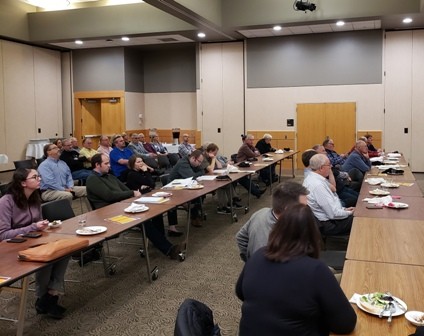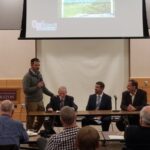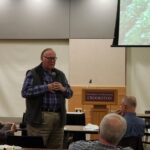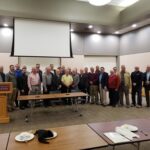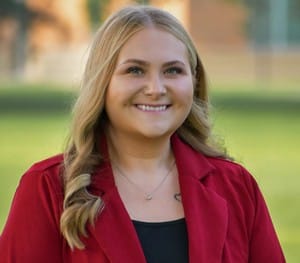The Senate Capital Investment Committee visited Crookston on Wednesday, and the City of Crookston leaders along with their many partners took part in a significant step toward securing bonding for infrastructure for the development of the Colburn Property south of Titan Machinery. In addition to the investment committee U.S. Representative Collin Peterson, former Minnesota Senator LeRoy Stumpf, and representatives from U.S. Senator Amy Klobuchar’s office were also present to show their support for the project. Minnesota Senator Mark Johnson hosted the committee who is making a tour of the state to learn about the requests they’ve received totaling for than $5 billion.
Johnson said the committee visits the communities with requests to get a hands-on feel for the project, the city, and its investment, as well as what the return on investment will be for the State of Minnesota. “One of the things they are looking at is getting that hands-on,” said Johnson. “What’s the feel of the community? Are they involved, are they invested in the projects that are going on? Secondly, what are a real need out there? You get all these sheets of paper that said – we need x million dollars for a project – maybe it’s something more of a preemptive project. They want to get a hands-on feel on what those requests are going forward. That’s what they are doing today. What the project looks like, what’s it going to be, what’s the return for Minnesota? How is this going to benefit the long-term? This is a capital bonding request, so we’re going to be making payments on this. How is the State of Minnesota going to benefit from this long-term? That’s what they are trying to figure out.”
Acting Mayor Dale Stainbrook, City Administrator Shannon Stassen, and Crookston Housing and Economic Development Authority (CHEDA) Executive Director Craig Hoiseth presented on behalf of Crookston’s request for $7 million in bonding. The bonding dollars would be used for earthwork, roads, and site utilities on the Colburn property. Additionally, the City of Crookston and Epitome Energy will partner to provide another $7,216,626 million in matching funds. That makes up nearly 50 percent of the total infrastructure for the development of the site, with another $15,329,164 for additional infrastructure coming from Epitome Energy, grants, and other funds for the deep foundation, rail tracks, substation, and additional deep foundation bins.
The Agricultural Utilization Research Institute (AURI) also had a short presentation. Initial plans have AURI working closing with the University of Minnesota Crookston and the Soy Innovation Campus on the property. AURI Microbiologist Dr. Jimmy Gosse discussed AURI’s plans to further research at the campus in areas such as high oleic soybean oil, a protein highway initiative, value-added soybean processing, and using alternative feedstocks to create new coproducts.
The Soy Innovation Campus will be the center of testing new uses for soybeans and other plants. It will also test new technologies in processing Tom Slunecka, the Executive Director/CEO of the Minnesota Soybean Research & Promotion Council, and Minnesota Soybean Growers Association told the committee. The Soy Innovation Campus will be run as a non-profit that will work collaboratively with Epitome Energy and other businesses that will build on the property. Different companies will have a variety of applications for using soybean and other plant oils, one example being soybean oil-based asphalt sealant.
Slunecka was asked what the newly announced plan by Governor Tim Walz to revamp Minnesota’s emission standards to mirror California would have on the industry. Slunecka said that there is an untapped demand for biodiesel that will rise in the next three years and added that New York will require 25 percent of all heating oil to come from biofuels. Slunecka acknowledged that hydrogen, electricity, and wind are all good but that one won’t kill another because the demand for energy is unstoppable.
Curt Knutson, Chairman of the American Crystal Sugar Board of Directors, told the committee that soybeans are one of the rotational crops used by Sugar Beet growers in the region who currently kind of break-even with their rotational crops. He told the committee the opportunity to find a better market for soybeans could help local farmers capture some revenue and profit on soybeans for a change.
Senator Dave Senjem, chair of the Senate Capital Investment Committee, concluded the meeting with a short thank you. Senjem noted that he knows there are communities across Minnesota that are moving along and other cities that are stuck before thanking and congratulating Crookston and CHEDA for stepping up and thinking broadly about how to make Crookston better and stronger economically.
Hoiseth said he was happy with the result of today’s first opportunity to interface with the investment committee. “We had a very strong contingent today from the Capital Investment Committee from all over the state,” said Hoiseth. “The chairman afterward complimented us on our vision for Crookston and trying to bring vibrancy to Crookston that doesn’t exist today. We were really happy with the result. We were able to ask very clearly that the City of Crookston needs help from the state in the term of $7 million bonding matching funds. Crookston itself and our customer Epitome Energy would combine another $7 million. That would create $14 million of the total $29 million infrastructure budget.”
Hoiseth also commented on the comprehensive support of officials and organizations in developing the Colburn Property for the Soy Innovation Campus, Epitome Energy, and other soy-based businesses. “Very clearly demonstrated that there is a lot of stakeholders up in northwest Minnesota,” said Hoiseth. “Minnesota Soybean, Soybean Growers Association, the growers themselves, AURI, the City of Crookston, just a large contingent of people some of them presenting and some of them listening. Representative Peterson was here, representatives from Senator Klobuchar’s office. We felt there was a wide breadth of folks here supporting us today. School District, everybody is in favor of this project. We have to find the way to lift it off the ground.”
City Administrator Shannon Stassen echoed that it was a good day with lots of support from people in favor of the project. “I think the most important thing is Crookston put on their best face and presented very well,” said Stassen. “We had a lot of folks show up in favor of the project, so it was a good day.”
Hoiseth explained that today’s initial meeting with the committee was an overview at the “30,000-foot level” with future interaction in St. Paul refining the specifics. “Today gave them kind of the 30,000-foot look into Crookston,” said Hoiseth. “Telling them what the concept looks like, what we’ve done to this point in time. Over the next couple of months, we’ll refine our message. Then be spending some time in St. Paul interfacing with these committee members and other legislative folks talking about Crookston, the project, and how necessary it is to get some bonding dollars to leverage the dollars we’re bringing forward.”
Stassen said the partnership between the City of Crookston, CHEDA, and Epitome Energy would now work on providing the specific information to the committee in the coming months and answering questions. “Lots and lots of information that we will provide,” said Stassen. “And we’ll look to this committee to see what other questions they have and make sure we get them answered.”
Johnson noted the importance of the committee’s visit as they will influence what the bonding bill looks like and what it accomplishes in the legislature. “These guys are the ones that will help influence that bill and what it looks like at the end of the day,” said Johnson. “So, it’s really good to have them here on-site looking at this.”
UMC Chancellor Mary Holz-Clause also presented Wednesday on the bonding bill for the University of Minnesota which totals $200 million, with $87 million in the request for Crookston for projects includes an upgrade to the natural gas distribution system and Owen Hall. Recent projects UMC has used bonding dollars for include the recently renovated chemistry and biology lab, an electrical upgrade, and upgrades to Lysaker Gymnasium including bringing the bleachers both up to code and making them ADA compliant.

